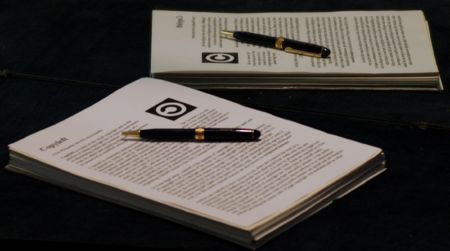Licenses
| WikiEducator Tutorials | ||
|---|---|---|
| Tutorial 12 | Introduction | Freedom as concept | Free content defined | Licenses | Free software and Free content | Summary & FAQs | |
Contents
The problem

This is a complex topic because property rights of creative works are typically regulated by national laws. So for example:
- a work that would be in the public domain in one country would not necessarily be in the public domain in another country; also
- works that were created before the existence of national copyright law would be in the public domain, for example the Bible.
However, copyright may exist in certain translations or forms of the publication of the Bible. Furthermore, there is the complicated topic of expiration which refers to the default duration of a copyrighted work before it can legally become part of the public domain.
Historically, before the inception of copyright law, a creative work would typically form part of the public domain unless licensed otherwise. This is no longer true because today copyright law, for most jurisdictions, is automatically assigned to the creator of the work, resulting in a serious depletion of works being generated for the public domain or intellectual commons. Public domain is not a license but, under modern copyright law, it normally requires a declaration or dedication that the work is in the public domain. However, as indicated above, this may be different in your own country.
In the creation of new free content, or modifications of existing free content, the WikiEducator community is not overly concerned with the intricacies of national copyright law. We are however interested in protecting our free choice to produce, modify and adapt free content.
The WikiEducator community does not incorporate copyright material into the wiki. Every time you make an edit on WikiEducator, you confirm that you are submitting original work under a free license, alternatively sourcing materials from the public domain or similar free resource.
Free content licenses
In this tutorial, we do not have the scope to cover all free licenses. We will, however, look at two of the most widely used free content licenses, namely the GNU Free Documentation License (FDL) and the Creative Commons licenses.
GNU Free documentation license
The GNU Free Documentation License was orginally developed by the GNU Free Software project as a license for documentation accompanying free software programs. The FDL is a copyleft license, as described in the previous subsection because it contains a share-alike provision.This is an important license because a large number of free content projects use this license, for example most of the Wikimedia projects. These projects represent a vast collection of content resources which you may want to adapt and modify for your own purposes, so it's important to be aware of this license.
The Creative Commons
The Creative Commons is a charitable US-based corporation that has developed a range of licensing options between two sides of a continuum. On the one side, total control associated with all "rights reserved" and, on the other, total freedom. Choosing a license does not mean that you give away copyright, it refers to the rights you may give members of the public and the conditions of use of your creative works.
The creative commons is a no "hassle" approach to assigning a license to your work, because all the legal work has been done for you. You simply need to select one of the creative commons licenses. Furthermore, the Creative Commons license has the additional benefit that it is expressed in three forms:
- A Commons Deed. A simple, plain-language summary of the license (intended for humans), complete with the relevant icons.
- The Legal Code. This is the fine print that you need to be sure the license will stand up in court (intended for legal professionals).
- The Digital Code. A machine-readable translation of the license that helps search engines and other applications identify your work by its terms of use. For example, this can be embedded in the markup of a web page.
| Choosing a Creative Commons License
The purpose of this activity is to provide you with an authentic experience in choosing a license.
|
If you are new to the question of the licensing of free content for education, you may have found the variety of choice for a Creative Commons license confusing. Were you certain about the legal and practical implications of your choices?
Creative Commons describe the license options as follows:
- Note that the logos above are official trademarks of the Creative Commons and are used here for illustrative purposes.
Creative Commons has made a significant contribution to unraveling the quagmire of widening rights and use of resources. Nonetheless it is still a daunting task for many educators in taking an informed decision about the "right" license. These issues are the foundation of a healthy debate in the Open Education Resource community.
The freedom "paradox"
There is a healthy debate in the Open Education Resource community regarding the implementation of the essential freedoms of the free content definition.
The Creative Commons license is reasonably well known in the education community and there is a strong association with this license and the sharing of content. However, only two of the six generic Creative Commons licenses are free. The strap line on the Creative Commons website reads: "Share, reuse and remix legally", which may convey the impression that all licenses permit unrestricted sharing and reuse - which is not the case. Some advocates of the libre community argue that this is misleading for the general public because there are configurations of the Creative Commons license that don't meet the requirements of the free content definition. These advocates argue that the Creative Commons should make a very clear and unambiguous distinction between which license alternatives are free and those which are non-free alternatives.
The counter argument is one of freedom of choice, namely that individuals should have the freedom to choose among the different license alternatives, including those configurations that restrict the use of the resource in a way that would not qualify as free content under the requirements of the free content definition. Supporters of this view contend that the public is provided with unrestricted access to tools, information and tutorials on what each of the license alternatives mean. They argue that this is an educational related challenge so that people can make informed choices.
To avoid any ambiguity, a Creative Commons license that contains any of the following restrictions doesn't meet the requirements of the free content definition:
- No derivative works
- Non commercial
Stated differently, the two Creative Commons licenses that meet the requirements of the free content definition are:
- Attribution (CC-BY)
- Attribution share-alike (CC-BY-SA)
To NC or not to NC in education
|
Links
- The Definition of Free Cultural Works provides a useful grid comparing different licenses for further reference.
- Creative Commons
- Reasons why not to use the NC restriction




